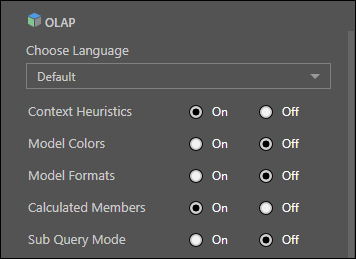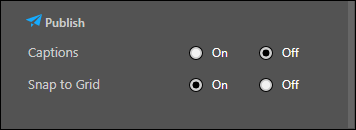User defaults are a set of options to drive the basic user experience for Pro users. These can be set administratively and then customized by each user for themselves.
Setting Defaults
To open the User Defaults panel, click the User Settings button (red highlight below) from the home menu on the home page. This will open the System Info panel; switch to the User Defaults view.
Default Options
Content Manager
- Presentation Launcher: sets how dashboards should load up from the content explorer:
- Slides View Mode: clicking on a presentation will show a preview of all its slides; open the presentation in edit mode, or click on a slide to open the presentation in runtime from the selected slide.
- Direct: clicking on a presentation will open it in runtime from the first slide.
- Content View: sets which view of the content manager to start with when a user first accesses the content system.

Discover
- Single Click/ Touch: users can interact with visualizations via the selection tools and the context menus. Select a data interaction type that should occur with a single left mouse click.
- Double Click: select a data interaction type that should occur with a double left mouse click.
- Slicer: set the default slicer type; when a new slicer is configured, it will use the default type. Slicers can be edited and visualized as a different type.
- Slicer Elements Limits: set the maximum number of elements to be returned by a slicer.
- Visual: set the default visual; when building queries in Discover, they will automatically be displayed with the default visual.
- Color Logic: set the default color logic for the color drop zone.
- Grid Design: set the default grid design.
- Slicer Execution: define whether slicer's default execution should be automatic or manual.
- Query Execution: define whether query execution should be automatic or manual.
- Default Tooltip: automatically show or hide the default tooltips.
- Empties: automatically show or hide empty cells in the query when working with MS OLAP or Tabular data models.
- Chart Scale Starts From: define the default start for chart axis scales; either 0 or automatic.

OLAP and BW
- Choose Language: set the language to the cube's default language, or to the application language (the currently selected language in Pyramid).
- Context Heuristics: automatically enable context heuristics when working with MS OLAP or Tabular data models.
- Model Colors: automatically enable model colors when working with MS OLAP or Tabular data models.
- Model Formats: automatically enable model formats when working with MS OLAP or Tabular data models.
- Calculated Members: automatically include calculated members from the cube structure in the query.
- Sub Query Mode: automatically enable sub query mode when working with MS OLAP or Tabular data models.
- Optimize Totals: automatically enable optimize totals when working with MS OLAP or Tabular data models.

Present
- Show Panels: turn visualization panels on or off by default.
- Auto Interact: enable auto interaction by default.
- Snap to Grid: enable snap to grid by default.

Publish
- Captions: enable captions by default.
- Snap to Grid: enable snap to grid by default.
